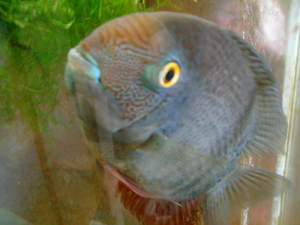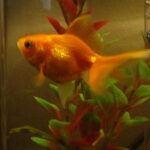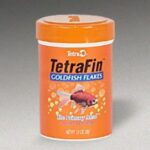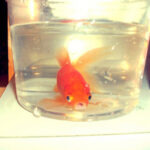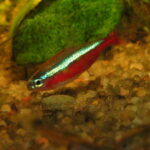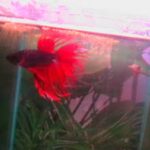Keeping an aquarium is a fairly common hobby. Many people have goldfish or guppies, which are perfect for children and families on the go. If you want to go further with keeping an aquarium at home, however, consider cichlids.
Cichlids are a large family of fish (over 1500 varieties) that span much of the globe – North, Central, and South America, Africa, India, and the Middle East. They are almost excusively fresh water fish, though a very few can live in brackish water. Where a cichlid is from determines what sort of care it needs. Generally, a cichlid from Africa cannot be in the same tank as a South American cichlid, because they have vastly different water chemistry requirements.
Cichlids come in an astonishing array of sizes and colors. Some of the African cichlids remain quite small and have vibrant colors. Some are rather plain-looking, like the Madagascar Polleni – a dark fish with lighter somewhat metallic spots. Others, like the Green Severum and ever-popular Oscar, can grow to be ten inches long and are strikingly beautiful.
There are many considerations when setting up any fish tank, but when setting up a tank for cichlids the main consideration should be size. Most retail fish are sold at about one inch size… yet many cichlids will grow to be eight to ten inches! If you start off with a twenty gallon aquarium, chances are you’ll wish you had an eighty gallon within a year! Overcrowded tanks are a primary cause of fish death due to stress and poor water chemistry.
It’s best to talk with more than one aquarist before purchasing your fish. It’s not uncommon to be given erroneous information about cichlids – often due to the aquarist’s personal inexperience with these fish. At minimum, you should learn what sort of fish suit your lifestyle and tank setup, how large they will grow, what water chemistry is ideal for your cichlids, what your fish will eat (and how much), and what the signs of illness are.
It’s often easiest, if you are new to keeping cichlids, to stick with a fish that’s easy to get information about if you run into trouble. The most common cichlid fish are Oscars and Convicts. They’re easy to raise, answers to questions you have are plentiful, and they don’t have a lot of highly specific requirements. If size is a concern, go with the convicts – their top size is under five inches.
If you don’t already know the basics about cycling fish tanks or water chemistry testing, you should start with less intensive fish. You should also have a good grip on filtration issues, tank cleaning and water changes, and fish emergency medicine. Some pet stores and aquarium retailers offer classes or instruction – but for the health of your fish, please gain some general fish-keeping experience before bringing home cichlids.
Most cichlids require a specific pH to be able to thrive. Testing the water’s pH is fairly simple – buy a test kit and follow the instructions. Some cichlids require pH as low as 6.5, and others need the pH to be 8 or higher! That’s why it’s very important to know your fish’s needs, because if you put a pH 6.5 and a pH 8 fish together, they will not thrive and could even die.
You should also know which chemicals can affect your fish and what the signs are of a problem. All fish tanks build ammonia, nitrites, and nitrates in a cycle that should end with each chemical being dealt with and removed from the water. If anything is off in your tank’s cycle, these chemicals can quickly build to toxic levels and hurt or kill your fish. Some fish are exquisitely sensitive to even a small rise in toxins. It’s vitally important to test your water on a regular basis and take immediate action if chemicals are building up.
Cichlid feeding can be a bit complex. Be sure to know what sort of foods your fish needs, and then feed a variety. Many fish like flakes or sticks, supplemented with green peas, zucchini, frozen cichlid treats or shrimp. Some fish have definite likes and dislikes – most polleni adore frozen shrimp, but ours won’t touch them! Never over-feed. It’s best to feed a little bit several times a day. If you will be out of town, try a vacation feeder but do several good water changes when you get back, to remove uneaten food.
Be sure to check into different kinds of cichlids before you purchase. They are all beautiful, but you should be sure to get the right fish or combination of fish. Even among fish from the same region, not all cichlids make good tank mates. Many of them are extremely aggressive and territorial. They can really hurt each other, so be careful who you put together, and have a backup plan in case they don’t get along. Some (like convicts) breed frequently. It’s a lot of fun to watch them raise their babies, but it’s not so much fun to see the babies get eaten by other fish in the tank! Others, like the Polleni, have very sharp teeth and will bite at anything that moves (including your fingers, so watch out!).
Setting up the fish tank can be fun – cichlids love natural environments like rocks, caves, and tree branches. Just be sure that whatever you use is safe for the aquarium. If in doubt, check with your pet store. Many cichlids like to dig in the gravel. Some will even pick up the gravel in their mouths and move it around, creating an endless variation in their environment.
Some cichlids can be trained to an extent. Many of the larger fish will eat cichlid sticks from your fingers. Be careful of their teeth, and also be careful because excited fish – especially Oscars – can jump right out of the tank in their eagerness to get at that food! Some cichlids like to play “kissy” with you. Just put your face up to the tank and kissy kissy! Most cichlids are extremely personable and even loving, which makes them an excellent choice for a pet!
Reference:
- Cichlids.com – tons of information on cichlids
